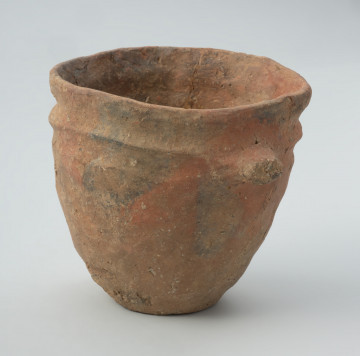
Conical cup
around 2350 p.n.e. — 2000 p.n.e.
National Museum in Szczecin
Part of the collection: Bronze Age
An amber disc in the form of a circular disk with a hole in the middle is one of the more intriguing archaeological relics. Due to its shape and golden honey colour, this type of pendants is interpreted as solar discs symbolising the cult of the sun. It was worn around the neck attached to a long thong, probably as an amulet protecting from evil powers or as an idol representing a deity. Together with clay vessels and flint arrowheads, the pendant was found in a grave with a inhumation burial, from which only single teeth survived. The burial ground, from which the presented monument comes, was known before 1945, but excavations were carried out there only in 1990-1992. It was due to increased sand mining and the resulting site destruction. The research was led by workers of the National Museum (Muzeum Narodowe) in Szczecin with archaeology students from the Adam Mickiewicz University in Poznań and Barnisław residents. In the effect of the works undertaken at that time, over 100 artefacts were salvaged, most of which were Lusatian culture cremation burials, and a few others were graves from the turn of the Neolithic and Early Bronze Ages. Only a few amber solar discs are known from the area of Western and Central Pomerania. Apart from the Barnisław specimen, six were discovered before the Second World War in Słonowice, Szczecin-Śmiardowo, Borne, Budowo, Węgornik, and Szczecin-Płonia.
Dorota Kozłowska
Author / creator
Dimensions
the entire object: height: 1.1 cm
Object type
pendant, amulet
Technique
drilling, grinding
Material
amber
Origin / acquisition method
field research
Creation time / dating
Creation / finding place
Owner
National Museum in Szczecin
Identification number
Location / status

around 2350 p.n.e. — 2000 p.n.e.
National Museum in Szczecin

150 — 200
National Museum in Szczecin

980 — 1100
National Museum in Szczecin
DISCOVER this TOPIC
Castle Museum in Łańcut
DISCOVER this PATH
Educational path